All chicken tractors generally have the same purpose – letting chooks go free-range without exposing them to hungry predators. But they have different features to suit the needs of the owner and the backyard where they will be used.
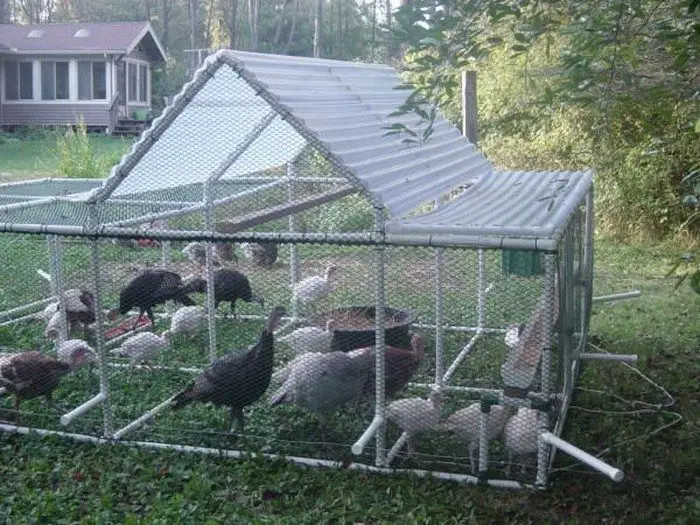
If you want a chicken tractor that’s low maintenance and easy to move, then you can use PVCs to build one!
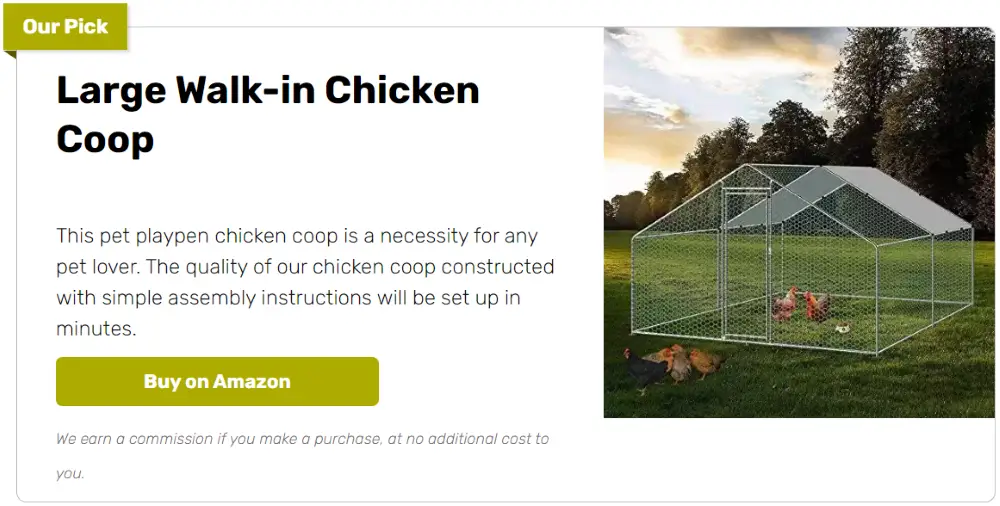
Unlike chicken tractors made of timber, a PVC chicken tractor is lightweight. You can build a larger PVC chicken tractor and still be able to relocate it without difficulty. It’s also rot-free which makes it perfect for places where it rains frequently. No need to repair or replace its parts every now and then, but should you need to, it should be easy!
Is this the kind of chicken tractor you are looking for?
Contents
Building a Chicken Tractor
Materials
- 21 ft of 3/4″ PVC
- 4 – Elbows for 3/4″ PVC
- 2 – 3/4″x3/4″x3/4″ PVC Tees
- 6 – 3/4″ PVC Couplings
- 40 ft of 1.25″ PVC
- 4 – 1.25″ PVC Street Elbows (one insert end)
- 2 – 1.25″ x 1.25″ x 1.25″ PVC Tees
- 8 – 1.25″ x 1″ x 1.25″ PVC Tees (reduce to 1″ at top)
- 6 – 1.25″ PVC Couplings
- 75 ft of 1″ PVC
- 4 – 1″ x 1″ Street Elbows (one insert end)
- 17 – 1″ x 1″ x 1″ PVC Tees
- 2 – 1″ x 1″ PVC Elbows
- 6 – 1″ PVC Couplings
- 25 ft x 3ft Chicken Wire
- 4 – 3ft x 8 ft Metal Roofing
- 200 – 8″ Cable Ties
- 200 – Self-Threading Sheet Metal Screws
- 1 – 6ft x 8 ft Tarp
- 7 – Bungee Cords
- PVC Cement
- 3 – 2″ Hinges
- 2 – 8 ft 2×2 Treated Wood
- 1 – 3 ft 2×4 Wood
- 4 – 1.75″ Wood or Drywall Screws
- 10 – 2″ long, quarter-inch diameter Machined Screws with Matching Wingnuts
- 2 – 8″ Utility Wheels
- 2 – 8″ long 3/8″ Carriage Bolts
- 6 – Washers for the 3/8″ Carriage Bolts
Tools
- PVC Cutter
- 2 Cordless Drills
- Carpenter’s Square
- Hand Saw
- Tin Snips
Instructions
Step 1: Planning and Design
- Sketch your chicken tractor design, noting dimensions and where each part will fit. Consider the size of the area where the tractor will be used and the number of chickens it will house.
Step 2: Cutting Materials
- Use the PVC cutter to cut the PVC pipes according to your design dimensions.
- Cut the chicken wire and metal roofing to size with tin snips.
Step 3: Assembling the Frame
- Lay out the pieces of the frame on the ground. Start by assembling the base using the 1.25” PVC pipes and appropriate connectors.
- Attach the 3/4″ and 1” PVC pipes to build the vertical supports and the top frame.
- Use PVC cement to secure all connections, ensuring the structure is sturdy.
Step 4: Attaching the Wheels
- Attach the 8″ utility wheels to one end of the tractor using the carriage bolts and washers. This will make the tractor easier to move.
Step 5: Installing the Chicken Wire
- Wrap the chicken wire around the entire frame, securing it with cable ties.
- Make sure there are no gaps where predators could enter.
Step 6: Adding the Roof
- Attach the metal roofing to the top of the frame using self-threading sheet metal screws. Ensure it provides sufficient coverage for shelter.
Step 7: Door Construction
- Build a door frame using the 2×2 treated wood.
- Cover the door with chicken wire and attach it to the frame with hinges.
- Ensure the door has a secure latch.
Step 8: Waterproofing
- Drape the tarp over the top of the tractor for additional weather protection. Secure it with bungee cords.
Step 9: Final Touches
- Inspect the tractor for any sharp edges or points where the chickens could be injured. Use PVC caps if necessary.
- Place the tractor in a preferred location and introduce your chickens to their new home.
Click on any image to start lightbox display. Use your Esc key to close the lightbox.![]()
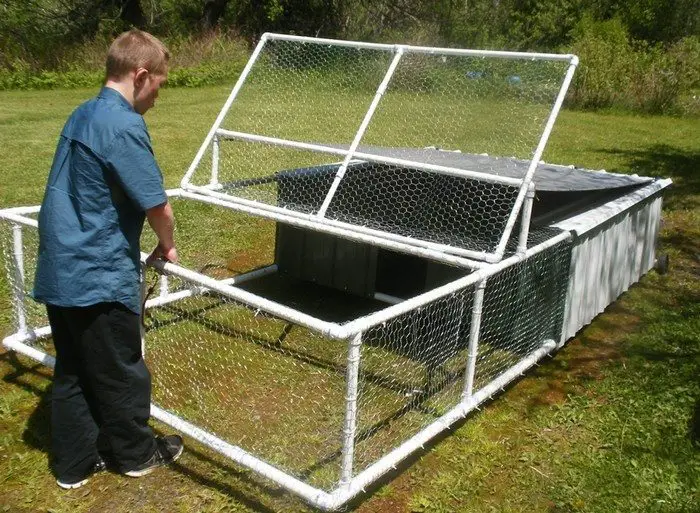

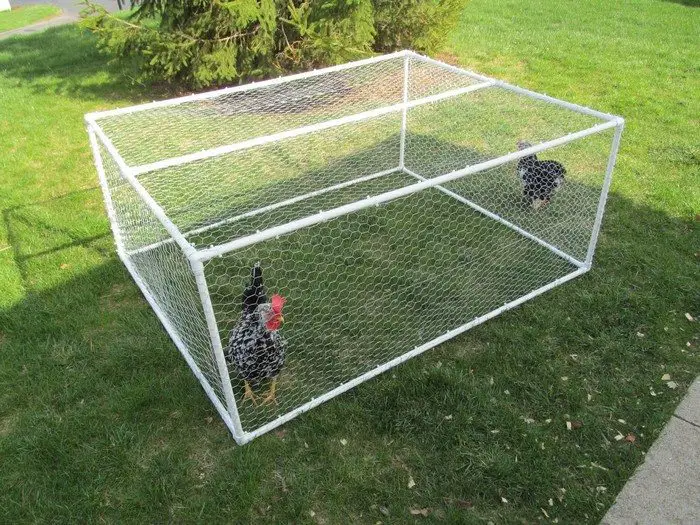
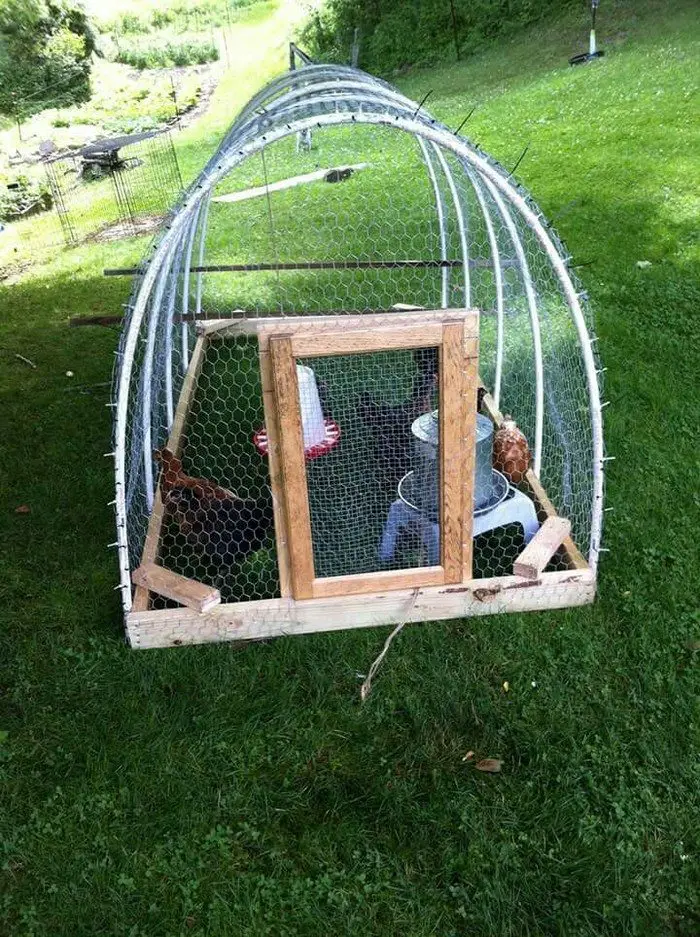
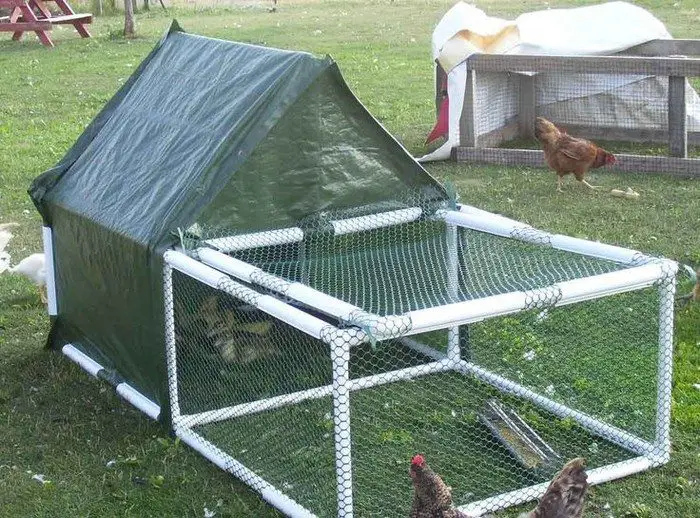
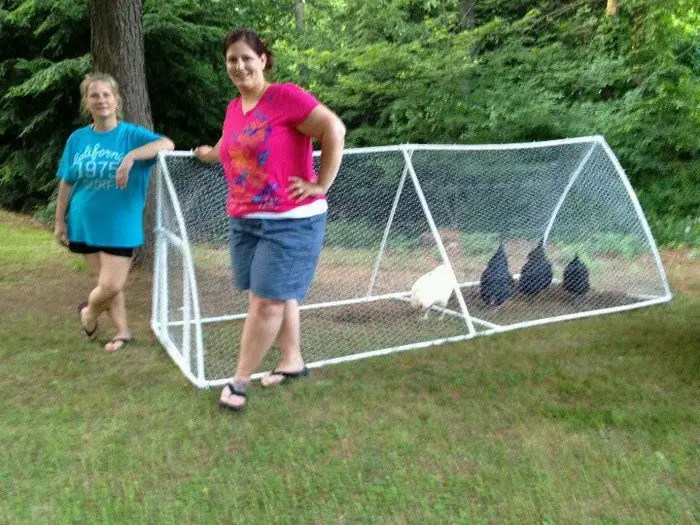
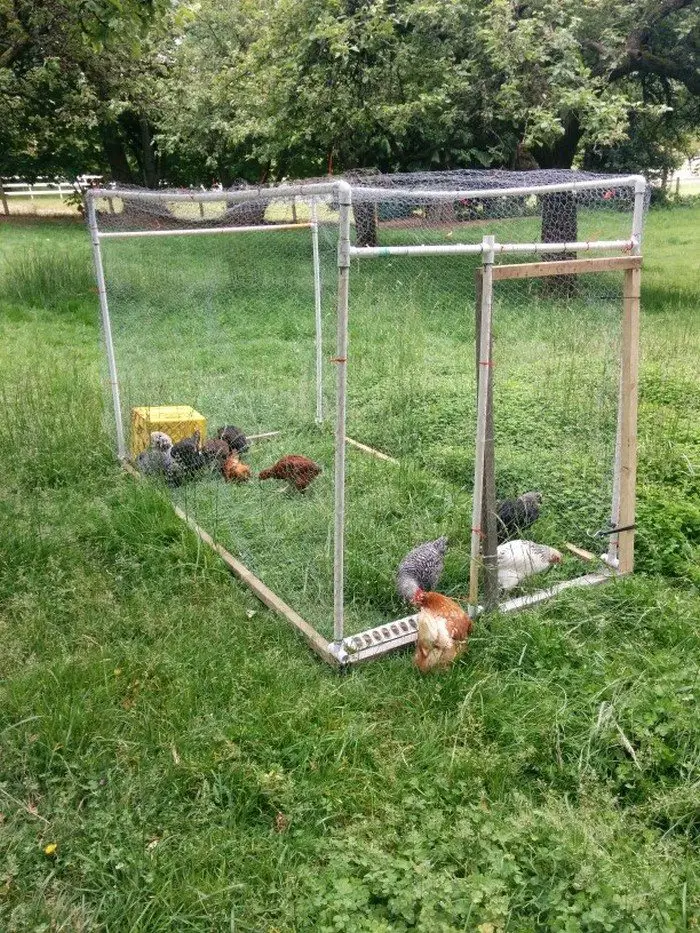
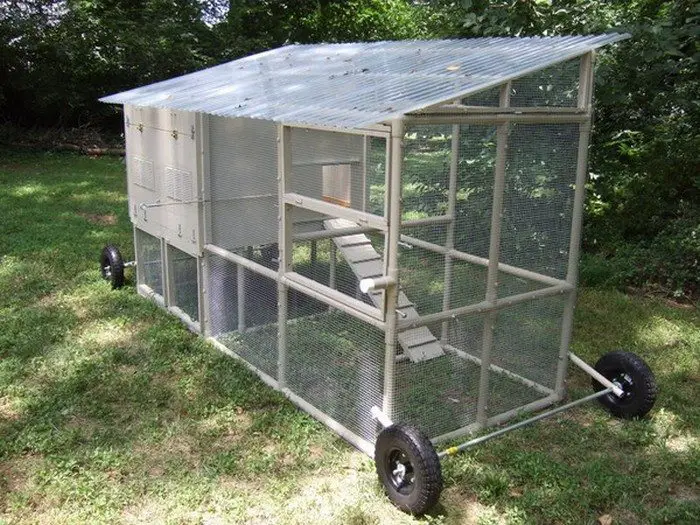
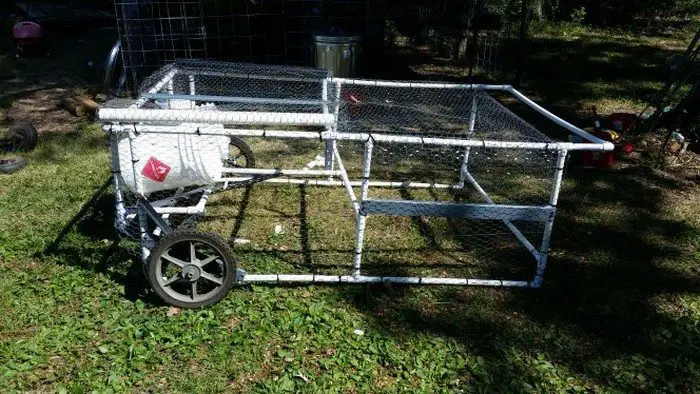
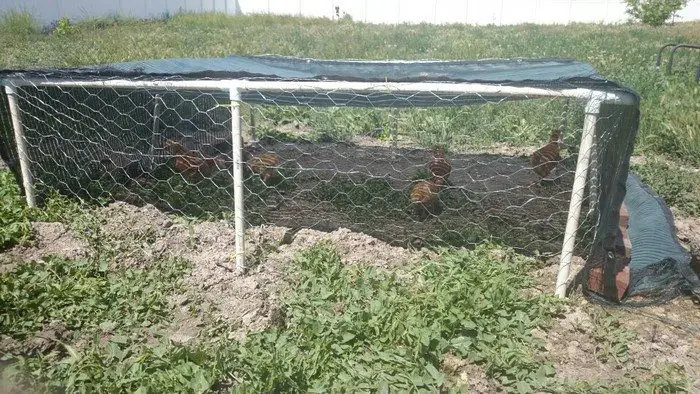


You can get more step-by-step instructions here…
Advantages of PVC Over Traditional Materials
For longevity, upkeep, and general operation of a chicken tractor, material selection is essential. Polyvinyl chloride, or PVC, is an often used substitute for conventional materials like metal and wood.
Here’s why PVC is the clear winner when it comes to constructing chicken tractors.
Lightweight and Portable
Lightweight and Portable PVC weighs a great deal less than metal and wood. Better rotation of your chickens throughout various areas of land is made possible by the ease with which PVC chicken tractors may be moved about your farm or yard. PVC is light-weight, which eases user strain and makes it perfect for frequent moves.
Low Maintenance
PVC resists environmental wear and tear far better than metal, which can corrode, or wood, which can decay. It is simply cleaned with ordinary home cleansers and doesn’t need to be painted or sealed. Because it resists deterioration, your chicken tractor lasts longer and requires fewer repairs or replacements.
Cost-Effective
Generally speaking, PVC is less expensive than metal and some kinds of treated wood. A PVC chicken tractor often has reduced initial material costs, and over time you’ll save money on maintenance because it’s long-lasting and low-maintenance.
Easy to Assemble and Customize
Cut and joinable with ease, PVC is a very adaptable material that permits a wide range of designs and alterations. It is harder to achieve with wood or metal the same degree of versatility with PVC, whether you need to change the size, add more compartments, or add more intricate details.
Weather Resistant
Many different climatic conditions are successfully tolerated by PVC. It is a great option for rainy weather or high humidity areas because it won’t break down in UV light or absorb moisture. This resistance makes sure that, whether rain or shine, your chicken tractor is safe and secure for your birds.
Non-Toxic and Safe
Correctly made, PVC is safe for both people and animals. Because it doesn’t leech dangerous chemicals, sheltering chickens who may peck at their surrounds is safe.
Choosing PVC above more conventional materials like metal and wood can greatly extend the life and usefulness of chicken tractors. For backyard farmers and chicken lovers wishing to provide their birds the finest care possible, its mix of robustness, simplicity of usage, and economy of cost makes it a great option.
Maintenance Tips for a PVC Chicken Tractor
Maintaining a PVC chicken tractor is essential for ensuring it remains a safe, clean, and durable home for your chickens. PVC is already a low-maintenance material, but regular upkeep can extend its lifespan and keep your chickens healthy and happy. Here are some practical tips for maintaining a PVC chicken tractor:
Cleaning Frequency and Products
Clean your chicken tractor at least once a week to prevent the buildup of droppings and reduce the risk of disease. Use mild soap and water for general cleaning. For more stubborn areas, a vinegar and water solution can be effective. Avoid harsh chemicals as they can damage the PVC and may be harmful to your chickens.
Focus Areas
Pay special attention to the joints and connectors where dirt and bacteria can accumulate. Ensure that the chicken wire is free from debris that might cause injury or blockage.
Routine Checks
Regularly inspect all connections and fittings on your chicken tractor. PVC connections can loosen over time due to movement or environmental changes.
Securing Loose Parts
If any parts are loose, use PVC cement to reaffix them or replace them if they show signs of wear. This prevents structural weakness that could lead to collapses or escapes.
Visual Inspections
Look for any cracks, splits, or significant scratches in the PVC pipes. These can compromise the structural integrity of the chicken tractor.
Immediate Repairs
Repair any damage immediately to prevent further deterioration. Small cracks can be sealed with PVC cement, while larger damaged sections might need to be replaced.
Protection Measures
If your area experiences extreme weather, consider additional weatherproofing measures. During winter, extra tarps or insulating materials can protect your chickens from cold drafts. In summer, ensure adequate ventilation and shade to prevent overheating.
Regular Monitoring
Check for signs of pests such as rodents or insects that might be attracted to the feed or bedding.
Preventative Actions
Use natural deterrents or safe pest control methods to keep these pests away from your chicken tractor. Make sure any methods used are safe for your chickens.
Mobility Maintenance
If your chicken tractor has wheels or other moving parts, ensure they are well-lubricated to prevent rusting or jamming. Use a silicone-based lubricant for the best results.
Change Frequency
Change the bedding inside the tractor regularly to keep the environment clean and dry. This reduces the chance of diseases and keeps the chickens comfortable.
Scheduling Deep Cleans
At least once a month, perform a thorough deep clean of the entire tractor. This involves dismantling it as much as practical and cleaning each part individually.
By keeping your PVC chicken tractor clean, sturdy, and comfy for your hens, you can eventually improve their health and output.
Conclusion
Building your own PVC chicken tractor offers a practical and efficient solution for raising chickens safely and sustainably. This DIY project not only provides a secure space for your poultry but also allows easy mobility to fresh grazing areas. With a little effort and the right materials, you can create a durable and low-maintenance home for your chickens that will serve them well for years to come.
We have more ways to keep your chicken healthy. Check out our chicken playground ideas next!





